PREVIOUS
Science and Technology in Modern India - VII
November 27 , 2019
2226 days
14434
0
Defence Technology - II
K Missile Series
- The K family of missiles is a submarine-launched ballistic missile (SLBM).
- They are being developed to provide second-strike capabilities and they are nuclear deterrence.
- There are three variants: K-15 (Sagarika), K-4 and K-5.
- K-15 has 750 km range.
- K-4 missile has two sub-variants, one with 3,500 km range and the other with 5,000km range.
- K-5 is under development with a range of 6,000 km.
- The K family of missiles are used with nuclear powered Arihant class submarines.
BrahMos II
- It is a hypersonic cruise missile and it is the second of the BrahMos series of cruise missiles.
- It is expected to have a range of 290 km and a speed of Mach 7.
- It will be powered by a scramjet engine instead of a ramjet one.
Anti-Satellite Missile
- DRDO developed anti-satellite system called A-SAT.
- It successfully destroyed a live satellite in the Low Earth Orbit on March 27, 2019.
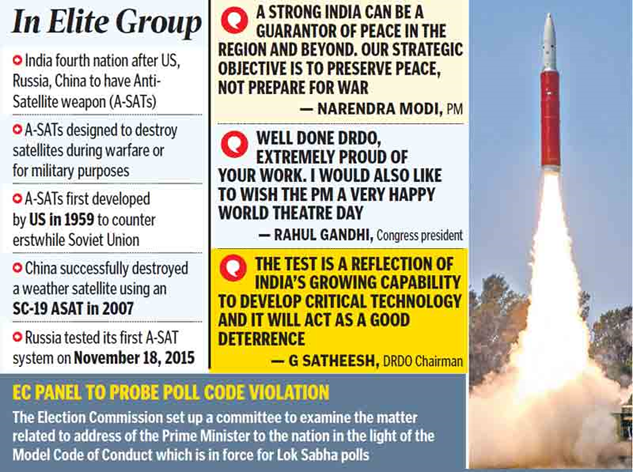
- This was dubbed as Mission Shakti.
- With this, India is only the fourth country after the U.S., Russia and China to have the technology.
- It struck a predetermined target: a redundant Indian satellite (Microsat R) that was orbiting at a distance of 300 km from the Earth’s surface.
India’s Ballistic Missile Defense System (BMD)
- India’s BMD development began in 1999, after the Kargil war.
- The primary aim is to bolster India’s defence against possible nuclear attack from Pakistan.
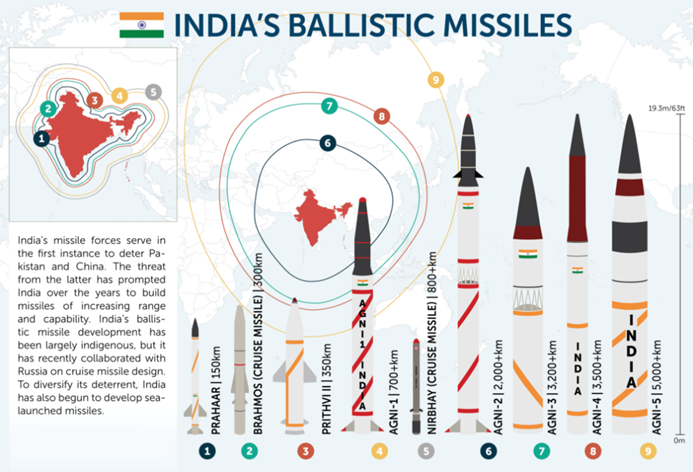
- It holds a place of prime importance especially when India follows ‘No first use’ policy.
- India seeks to deploy a functional ‘iron dome’ ballistic missile defence (BMD), incorporating both low-altitude and high-altitude interceptor missiles.
- India’s BMD is primarily developed by DRDO with help of many public and private firms like BEL, Astra Microwave, L&T, etc.
- India’s BMD is being developed in 2 phases:
- The first phase aims to develop a shield to intercept missile with a range up to 2000 km.
- 1st phase radar range is up to 600 km.
- The second phase will have intercept missile with 5000 km range.
- Radar range of this phase would be 1500 km.
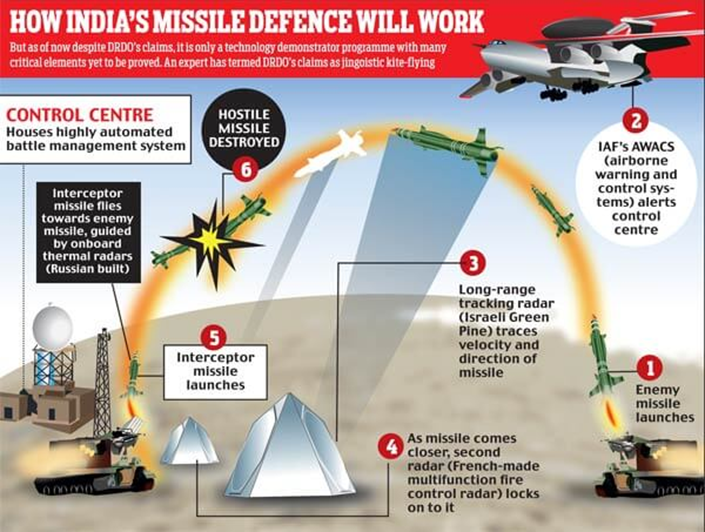
Two- tiers of India’s BMD
- They are Prithvi Air Defence (PAD) and Advanced Air Defence (AAD) respectively.
1. Prithvi Air Defense (PAD)
- India’s ballistic missile defence got a boost with the development of PAD.
- It is also referred as Pradyumna Ballistic Missile Interceptor.
- It is designed for High altitude interception (exo-atmospheric interception).
- The system was tested with a maximum interception altitude of 80 km.
- It has been designed to neutralise missiles within a range of 300-2000 km up to a speed of Mach 5.0.
- The interceptor is Prithvi Defence Vehicle (PDV) which has two-stage, both with solid propellants.
- The technology employed in the PAD was the forerunner to the indigenously developed Advanced Air Defence (AAD) interceptor missile which was tested in 2007.
- The Barak-2 was developed in collaboration with Israel.
2.Advanced Air Defense (AAD)
- It is also called Ashwin Ballistic Missile Interceptor.
- It is endo-atmospheric interception system (for low altitude interception).
- Altitude of interception is range up to 30 km.
- It has single-stage solid fuelled missile.
- On 6th December 2007, AAD successfully intercepted a modified Prithvi-II missile acting as an incoming ballistic missile enemy target.
- On 6th March 2011, India launched its indigenously developed interceptor missile from the Odisha coast.
- On 6th April 2015, an improved AAD was tested.
- The missile was launched from a canister for the first time and the composite rocket motor fired successfully.
- On 3rd August 2018, a successful test was carried out by one of multiple incoming targets simulating 1500 km class ballistic missiles was destroyed.
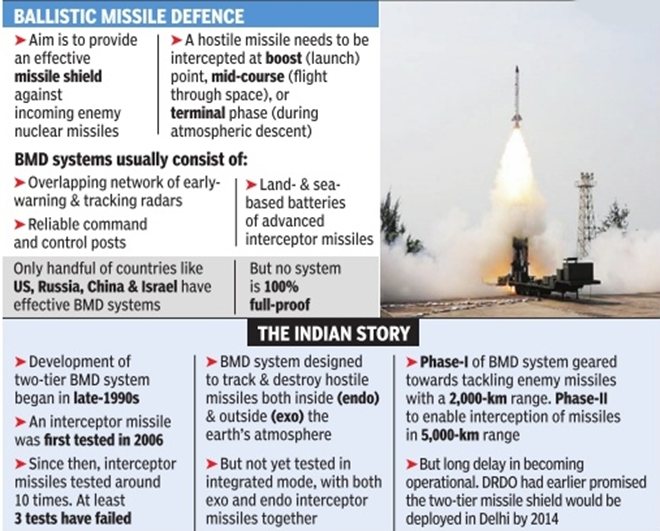
Radar Systems
i. Swordfish Radar
- Swordfish is a long-range tracking radar developed for the BMD system.
- It was derived from the Israeli Green Pine long range radar.
- It is capable of successfully detect, track and stop inbound ballistic missile threats.
- The radar can detect very small targets as small as a cricket ball within the range of 600 km-800.
- Swordfish guides the exo-atmospheric interceptor missile PAD to engage aerial targets at altitudes over 80km.
ii. Indian Doppler Radar (INDRA)
- The Indian Doppler Radar (INDRA) series of 2D radars were developed by India's DRDO for the Army and Air Force.
- The INDRA-I is a mobile surveillance radar for low level target detection while the INDRA-II is for ground-controlled interception of targets.
- INDRA-I was the first large radar system designed by the organization and produced in number for the defence forces.
- It was also exported to Sri Lanka.
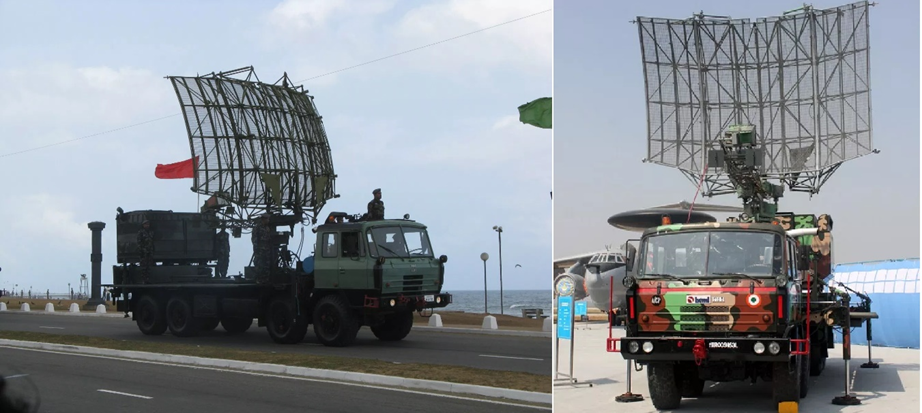
iii. Battle Field Surveillance Radar
- It is a man portable 2D short-range battlefield and perimeter surveillance radar.
- This radar has been a boon to Indian forces at LOC.
- It is used by Indian Army and BSF (Border Security Force) along with foreign customers like Indonesia and Sudan.
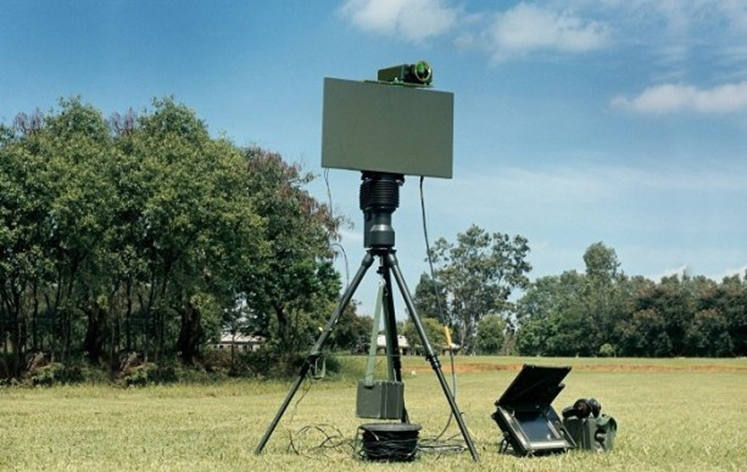
iv. Rajendra Radar
- It is a multifunction electronically scanned phased array Radar which is the heart of Aakash Air Defence System.
- It is a Passive Electronically Scanned Array (PESA) radar and is used to guide Aakash missile to its target.
- Mounted on a two wheeled vehicle it fulfils multiple radar functions like surveillance, tracking and guidance.
- It can track 64 targets and engage 4 targets at a single time.
- Its range extends up to 80 kilometres and at an altitude of 18 km.
v. ROHINI Radar
- The Rohini is an operating in S-Band ground-based 3D medium range air surveillance radar providing detection and tracking air targets even under hostile Electronic warfare operational environment.
- It is capable of handling multiple targets simultaneously and also precisely calculate the height at which projectiles are flying.
- Operating in a range of upto 170 kilometres and an altitude of 15 kilometres.
- The Rohini radar can track multiple targets like fighter jets and missiles travelling at supersonic speeds of over 3,000 kms per hour.
- A Secondary Surveillance Radar (Identification friend or foe-IFF), is integrated with the primary radar Rohini, which distinguishes friendly and hostile aircraft.
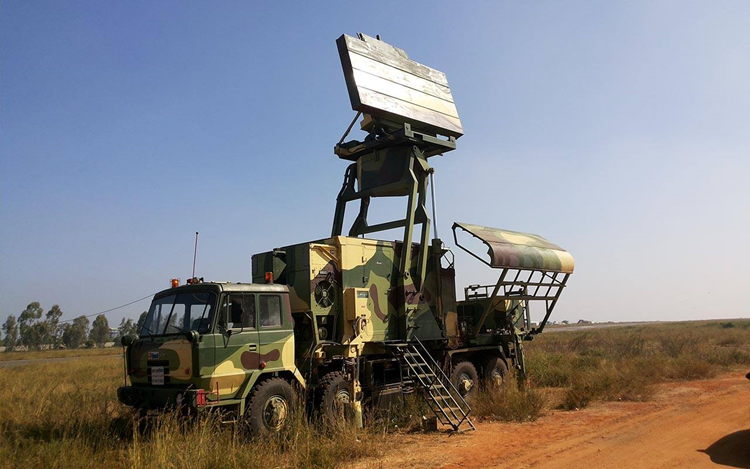
vi. Swathi Weapon Locating Radar
- The Swathi Weapon Locating Radar (WLR) is a mobile artillery locating phased array radar developed by India.
- This radar is designed to detect and track incoming artillery and rocket fire to determine the point of origin.
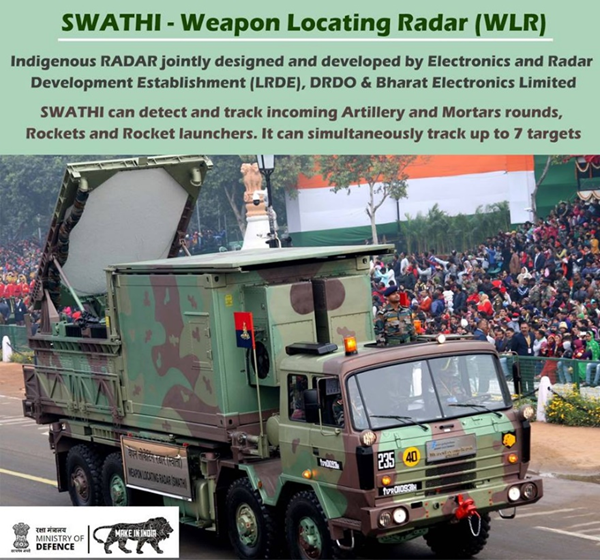
- It can also track and observe the fall of shot from friendly guns and provide fire corrections to counter-battery fire.
- The detection range for large calibre artillery rounds is up to 30 km, and increases to 40 km for unguided rockets.
- Up to 7 targets can be tracked simultaneously by this RADAR.
- The whole array can be rotated by 135° on either side within 30 seconds to quickly change the scanning sector in response to threats.
vii. Arudhra Medium Power Radar
- It is also known as a Medium Power Radar which is capable of automatic detection as well as tracking of aerial targets right from fighter aircraft to slow-moving targets.
- Arudhra is capable of tracking a small fighter sized target (Radar Cross Section of 2 sqm) as far as 300km at an altitude between 100 meters to 30 km.
- The radar can remain operational in intense jamming and interference.
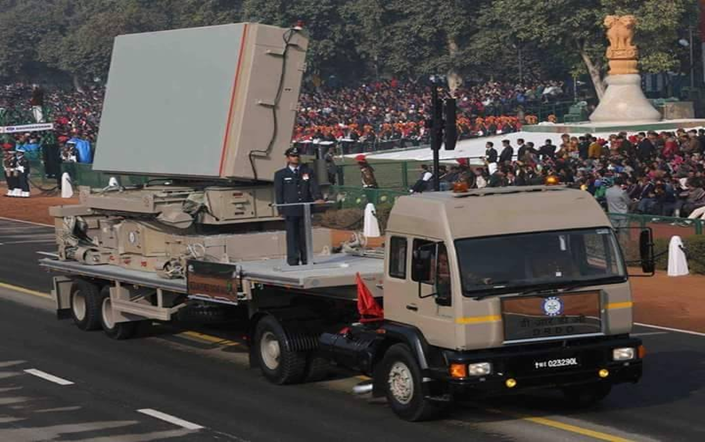
¶ ¶ ¶ ¶ ¶ ¶ ¶ ¶ ¶ ¶
Leave a Reply
Your Comment is awaiting moderation.


